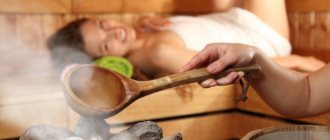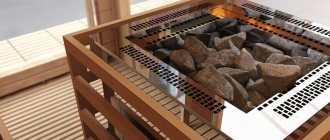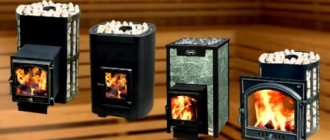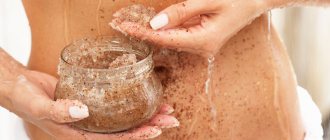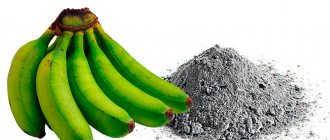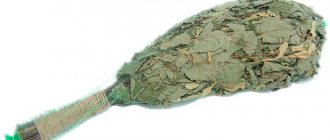The traditional material for building a bathhouse is wood. And this is no coincidence; the benefits of bath procedures are most fully manifested in a log steam room, in which a special microclimate is created, filled with the healing aromas of natural wood. But on the other hand, high humidity and extreme temperatures characteristic of a steam room do not have the best effect on wood, which quickly deteriorates in such conditions. Treating the bath with oil will help prevent destructive processes. In this regard, in the article we will focus on two main points: what are the best oils and impregnations to use in a steam room, as well as how to properly treat the internal surfaces of a bath with oil compositions.
The need for bath treatment
As noted above, a bathhouse is a room with special conditions in which high temperatures and humidity are constantly present. Wood is characterized by high hygroscopicity, that is, it strongly absorbs moisture.
In a steam room, the tree becomes an ideal environment for the development of pathogenic processes. Microorganisms appear in it, insects settle, mold and mildew form. As a result, the tree can completely turn black and turn into dust.
Once the process has begun, it is very difficult to stop, especially when it comes to a fully functioning steam room. To prevent the occurrence of such manifestations, it is necessary to protect all internal parts of the bathhouse frame in advance at the construction and finishing stage by treating them with special compounds.
There are many products for interior treatment of a wooden house and bathhouse. This review is dedicated specifically to oils, so we will only consider oil formulations.
Advice from experienced sauna lovers
Recipe from Olympic boxing champion V. Safronov
A teaspoon of pre-fried mustard is diluted in a bowl of water. It is splashed onto the hot stones. Mustard steam is used to fight the flu.
Recipe from hockey player Anatoly Firsov
Watermelon or melon juice is mixed with water and sprinkled over the heater. Fruit steam perfectly softens the skin, making it soft and elastic.
What oils are suitable for baths
Oil is a traditional bath treatment product. In earlier times, when there was not such a variety of means for protecting wood, steam rooms were covered with expensive oils of anise, rose, and lavender.
These compositions not only protected the log walls from moisture and rot, but also filled the room with a special natural aroma. Inexpensive hemp and linseed oils and wax were also used for processing, which have not lost their relevance today.
All oil compositions used in the steam room can be divided into two large groups:
- For treating walls and ceilings.
- For impregnation of benches and other surfaces in direct contact with the skin.
General requirements for oils for steam room processing
- Oil impregnation should provide reliable protection to the wood, and at the same time should not deprive it of its ability to breathe.
- An important condition is the environmental friendliness of the oil composition. Therefore, to cover the bath room you need to choose natural products. Synthetic impregnations contain chemical components that, when exposed to high temperatures, form harmful volatile compounds that are released into the atmosphere. In a small confined space, harmful substances are especially dangerous and can cause serious poisoning.
- For a bath, it is necessary to use moisture-resistant impregnations that are well absorbed into the wood structure, protecting it from moisture.
Products for treating walls and ceilings
When choosing a wood preservative to cover the internal surfaces of the steam room, in addition to the special conditions of the bath room, it is necessary to take into account the type of building material. Usually these are logs or clapboards. For floors, walls and ceilings made of these materials, you can use non-toxic acrylic-based varnishes, which do not emit any odor at high temperatures, natural oils and waxes, as well as special impregnations for saunas.
Acrylic varnishes form a protective film that can withstand temperature changes and exposure to water and steam. The varnishes contain antiseptics, so the surfaces do not require additional antiseptic treatment. Natura Teknos acrylic varnish has proven itself to be excellent, forming a translucent protective coating under which the wood grain is clearly visible.
One of the best means for internal treatment of wooden surfaces of a log bathhouse and a log house is linseed oil. This is an inexpensive natural product with antiseptic and hydrophobic properties. The oil penetrates into the deep layers of wood, providing it with reliable protection. The composition can be used both in pure form and in the form of a mixture with beeswax.
In addition to the pure product, there are various impregnations on sale based on linseed oil, which contain natural resins and pine turpentine. The most popular products are those under the brands Caparol, Tikkurila, and Remmers.
Oils for bath canopy
Manufacturers produce special oils for shelves that do not form a film on the surface, since when heated it can cause burns. In addition, the impregnation must be of high quality and should not cause allergic reactions on the skin.
- The oil compositions Sauna Natura from the Finnish manufacturer Teknos, Supi Laudesuoja from the Tikkurila brand, and Eurotex Sauna have proven themselves better than others in this group of products.
- A good wood preservative is carnauba orange oil wax. The product contains flaxseed and orange oil. The composition turns out to be very thick and resembles mastic in appearance. It is used to cover benches and backrests in saunas.
- Another product used to treat floors is beeswax. In addition to wax, the composition includes linseed oil and gum turpentine. This impregnation is less resistant to high temperatures than carnauba wax, so the coating will have to be renewed periodically, because Over time, its protective properties weaken.
Herbal infusions and teas
No less popular is the herbal bath - the use of aromatic herbs for the preparation of medicinal infusions and steaming.
Bath infusions have a pleasant aroma, which is enough to quickly saturate the air in the steam room. During the process of herbal inhalation, beneficial compounds penetrate through the upper respiratory tract and are carried along with the blood to all systems of the body.
What plants can be used to prepare medicinal infusions and teas? Since bath herbs have the same powerful effect on the body as medications, they are therefore widely used for preventive and therapeutic purposes during bath procedures.
In order for bath infusions to be beneficial and provide a high therapeutic effect, you need to know in what cases each type of plant can be used.
- Antiseptic and anti-inflammatory effects - chamomile, eucalyptus, calendula, oak bark, sage, linden.
- Sedative and calming effect - mint, lemon balm, chamomile, linden, lemongrass.
- Normalization of blood pressure - hawthorn and motherwort.
- Tonic effect - wormwood, juniper and rose.
- Relieving nervous tension and fatigue - pine, fir, juniper, eucalyptus, thyme.
- Anti-cold and expectorant - eucalyptus, lavender, linden, thyme, sweet clover.
- Accelerate metabolism, strengthen the immune system, detoxify the body - lavender, chamomile, mint.
To get the maximum effect from bath procedures, it is recommended to use fresh herbal infusions and bath steams. Steaming for a bath based on medicinal plants is sold ready-made at the pharmacy - small canvas bags containing the required set of herbs. If desired, you can make this decoction yourself.
To prepare a decoction for a bath with your own hands, you should first buy medicinal herbs at your discretion. We brew the decoction according to the recipe strictly in compliance with the proportions proposed by the manufacturer.
When performing bath procedures, it is not recommended to use alcohol tinctures to avoid drying out the mucous membrane.
Rules for applying oil impregnations
- Before applying impregnation, the surface is thoroughly cleaned of dust and dirt and, if necessary, the old coating is removed.
- Then the wood is sanded, dried and the dust and shavings formed as a result of sanding are removed.
- The impregnation is mixed well and applied to the surface with a short-bristled brush.
- Within 7-10 minutes after treatment, remove excess with a soft, lint-free cloth.
- The surfaces are allowed to dry and then polished.
- If necessary, repeat the treatment.
The drying time for each layer ranges from 4 to 24 hours. The exact time required for a particular product to dry is indicated in the instructions. In addition, the drying time is affected by the humidity and temperature of the room, as well as the absorbency of the wood species. In any case, it takes at least a day for the surface to dry completely.
For therapeutic and cosmetic effect
An indication for the use of essential oil does not necessarily have to be any disease. There are oils that have disinfectant properties. Not only do they have a positive effect on humans, but also the wood, which is used to make furniture and wall cladding, also removes unpleasant odors. Such remedies include chamomile, eucalyptus, mint, and oregano.
Cosmetic properties of esters
Table. Cosmetic properties of essential oils
| Problem | What to use |
| Dandruff, dullness, brittleness, hair loss and other problems associated with hair and scalp | of rosemary, santhal, lemon balm, and patchouli effectively combat the listed problems |
| Swelling, itching after insect bites | lemon balm and eucalyptus oil |
| Acne, malfunction of the sebaceous glands | Lavender, lemon, and sage oil will help |
| Aging skin | Rose and juniper oils have rejuvenating properties. |
| Dry skin | The problem will be solved by orange, jasmine, and patchouli oil . |
| General fatigue, pain syndrome | Eucalyptus, lemon balm, fir, juniper, basil, rosemary. |
rosemary essential oil
The following oils are used in aromatherapy:
- Natural aphrodisiacs - jasmine, rosemary, sandalwood, vanilla, bergamot create a romantic mood.
- Using rosemary and geranium , they stimulate brain activity, memory and ability to work.
- Grapefruit oil will help restore strength and vitality and get rid of nervous tension .
- Fir and cedar oil will help you get out of depression and cope with neuroses
- Jasmine helps you fall asleep gently , and orange .
- Lavender oil helps get rid of irritability .
Note! You can mix several oils to create different compositions to achieve the desired effect.
Essential oils can be mixed
Features of oil treatment
- If pure oil (usually linseed) is used, it is heated to 50-60 degrees before processing.
- The composition is applied either with a brush with natural bristles or with a cotton cloth.
- Apply the oil in a thin, even layer.
- The product is applied 5-6 times with layered sanding.
- After covering the next layer, wait for it to dry, then sand and apply the next one.
- It takes at least 2-3 weeks for a surface coated with linseed oil to completely dry.
If a mixture of oil and wax is used to process the bath, then the ingredients are taken in a 2:1 ratio to make it. To prepare the product, add heated wax to hot oil and then mix well.
The mixture is applied with a foam sponge strictly along the fibers. When the first layer has dried, remove the residue with a waffle cloth and treat the surface again.
For healing
Esters have a whole range of positive effects on a person’s physiological state and mood. The compositions destroy viruses, microbes, have healing properties, relieve pain, and strengthen the immune system.
Composition of natural esters
When heated, the activity of beneficial components increases many times over; they penetrate into the human body not only through the respiratory system, but also through the skin, strengthening the immune system.
Table. What problems can essential oil help with?
| Problem | What to use |
| Runny nose, dry lingering cough, colds | Esters obtained from juniper, anise or dill have pronounced anti-inflammatory and mucolytic properties, promote the liquefaction and removal of mucus. |
| Consequences of blood pressure surges, migraines | Using geranium oil, lemon verbena, basil and jasmine, you can relieve headaches and normalize blood pressure. |
| Neurosis, fatigue, depression | With the help of wormwood, rosemary, and Chinese lemongrass , you can cope with stress and calm your nerves. |
| Skin diseases: eczema and psoriasis, frostbite, itching, dermatitis, and also as a tonic | Esters obtained from pine, sea buckthorn, yarrow, sage, celandine, and valerian have soothing, healing, and regenerating properties. |
| Skin damage: cuts, cracking, scratches, peeling | Esters obtained from spruce, fir, cedar and pine relieve inflammation and restore affected areas. |
| Cleansing the body | Under the influence of hot steam, esters obtained from lemon, juniper or sandalwood stimulate the sweat glands, through which toxins are eliminated from the body. |
For a bath you can buy a ready-made collection of oils
These are not all types of oils and the healing properties that can be achieved when using them in a bath. For example, using mint you can improve blood circulation, sage is recommended to improve immunity, and cypress during menopause to relieve syndromes.
pine essential oil
juniper essential oil
Why is there impregnation in the bath?
Since wood is a natural and absolutely safe material, it is often used for interior decoration. But at the same time, it strongly absorbs moisture, as a result of which the surface becomes loose and is an excellent habitat for microorganisms, in particular fungi. Bacteria that have settled in wooden cladding through their vital activity provoke deterioration of the material and the collapse of the structure.
The market offers a fairly wide range of impregnations for saunas and baths, which are capable of creating a coating that protects the casing from the destructive effects of high humidity and temperature changes. In addition, they have excellent antiseptic properties. The undeniable advantage of such products is the ability to give the surface an attractive appearance, performing the function of a decorative finish.
Note! When choosing impregnation for baths and saunas, you should give preference to products that do not emit toxic substances.
Antiseptic impregnation for a bath allows you to extend the service life of the internal lining, preserve its appearance, and protect it from rotting and mold. These are unique products that do not form a film on the surface of the wood and do not prevent it from breathing.
Top cheap flavors
Bath items “Fir” 100ml
The product has an anti-inflammatory effect. Sold in a 100 ml bottle. To obtain effective results, use 15 drops of the product.
fragrance Bath things “Fir” 100ml
Advantages:
- Relieves colds and runny nose;
- Has anti-inflammatory, analgesic properties;
- Improves vision;
- Affordable price – 60 rubles;
- Restores immunity.
Flaws:
- Uneconomical product;
- Causes allergic reactions.
"Pine" 250 ml
This drug costs only 78 rubles. It contains water and natural pine oil. Sold in a 250 ml bottle. Dilute 1 ml per 10 ml. water. Watering the hot stones.
flavoring “Pine” 250 ml
Advantages:
- Economical packaging. It will last for several uses;
- Natural ingredients;
- Positively affects muscles and joints;
- Removes toxins from the body;
- Disinfects the room;
- Helps relax;
- Helps cleanse the respiratory tract.
Minuses:
- Counterfeits are often sold;
- Causes allergies;
- The price does not match the quality
.
"NORTH SOUTH"
This unique preparation contains orange and pine oils. Sold in a 100 ml bottle. The flavor costs only 100 rubles.
flavoring "NORTH-SOUTH"[
Advantages:
- Natural composition;
- Helps you concentrate and solve difficult problems;
- Clears the respiratory tract;
- Invigorates and improves the condition.
Flaws:
- Causes allergic reactions.
STEAM-ecology Amur Cedar, 200 ml
The product is sold in a 200 ml bottle. Combines the aromas of Amur cedars, which makes the product very beneficial for the body.
flavor STEAM-ecology Amur Cedar, 200 ml
Advantages:
- Convenient, economical packaging;
- Completely natural composition;
- Tones and rejuvenates the skin;
- Calms the nervous system;
- The flavor costs only 190 rubles;
- Goes well with other essential oils.
Flaws:
- The product has no disadvantages.
"Juniper", 300 ml
The scent costs 150 rubles. It contains an emulsifier. Sold in a 300 ml bottle. It must be shaken before use. Add 20 ml to a ladle of water. You can water walls and stones.
flavoring "Juniper", 300 ml
Advantages:
- Economical packaging;
- Affordable price;
- Removes excess fluid from the body;
- Promotes weight loss.
Minuses:
- Sometimes causes allergies;
- Odor intolerance.
What to choose
Specialized retail outlets offer a huge number of impregnations for wooden surfaces; they differ in use, form, and composition.
Before you make a purchase of one or another protective equipment, it is recommended to clearly determine what tasks it should cope with, namely:
- what surface will be treated (floor, ceiling, benches, shelves in the steam room, the entire room);
- will an additional decorative coating be used or will the surface after treatment remain the same as before;
- will the degree of moisture protection inside the bath be sufficient;
- Is the application method convenient?
An essential indicator of high-quality impregnation for baths, including those made from logs, is the combination of its moisture-proof properties with the ability not to prevent the skin from breathing. Since the presence of film leads to blockage of the wood structure and subsequent problems leading to damage to the surface. It is also worth paying attention to the environmental friendliness of the selected antiseptic. Otherwise, low-quality goods at high temperatures and high levels of humidity in the room will release harmful substances.
If impregnation is selected for treating floors, then after its application there should not be a slippery coating. Tabletops and benches should be treated with products designed for regular wet cleaning. There are shelf impregnations on sale that can completely penetrate the wood structure and prevent the formation of burns on the body at high temperatures.
Protective impregnations for wooden surfaces are divided into groups depending on the main component in their composition, as well as on the properties and method of application. According to the form of release, antiseptics are:
All types of impregnations for baths and saunas have water-repellent properties. Modern impregnations for baths rarely have only one function; they can often be used as universal preparations that can also protect wooden surfaces from the negative effects of elevated temperatures, excessive humidity and from damage by pathogenic microorganisms and harmful insects.
Based on their composition, the products are divided into water-soluble and oil-based. You can purchase a combined product in the form of varnish and paint, which is characterized by the effect of moisture protection and prevention from microorganisms. Most impregnations have additional performance qualities in the form of fire resistance and dirt-repellent function.
Aromatic plants and bath brooms
Aromatic plants and bath brooms can create a favorable atmosphere and aromas for a bath.
Plants
To create aromatic and pleasant steam during the construction of baths, special tree species with a high content of aromatic substances are used. Thus, pine needles are used for the frame, linden and aspen are used for interior decoration, and cedar or oak are used for decorative elements.
To create a cozy and healthy microclimate in the finished room, fresh or dried herbs and plants can be used, scattered on the floor, laid out on floor beams or hung on the walls. The best choice for a bath is herbs harvested with your own hands in ecologically clean regions.
For example, birch and pine branches, linden leaves and wormwood for a bath can saturate the steam with a soft and unique aroma, improve well-being and lift your mood.
Walls and ceiling surfaces can be sprinkled with pine tincture for disinfection and relaxation. Plants placed on the floor help heal microcracks in the heels, improve blood circulation and relieve fatigue in the legs.
Bath brooms
It’s hard to imagine a Russian steam room without a traditional attribute – a bath broom made from aromatic herbs. A natural bath broom provides an intense massage, warming up the muscle corset, improving blood circulation and a pleasant aroma.
Bath brooms are made from birch and oak branches, and in rare cases, spruce branches. Since ancient times, brooms made from birch branches have been used in steam rooms. They are distinguished by a high content of tanning components, vitamins and persistent aromatic substances, which can remain on human skin for up to 8 hours.
No less popular is a broom made from oak leaves containing tannins, which have a powerful anti-inflammatory and antibacterial effect. Oak broom has found its use in the prevention of diseases of the skin, joints and hypertension.
To get the maximum effect from the bath procedure, you need to steam the brooms correctly. Before use, brooms are immersed in cold water for 10–15 minutes, then immersed in hot water for 3 minutes. This will help soften hard leaves and saturate the air with tannins.
Preparing a coniferous broom is slightly different from previous options. To soften the needles, the product is immersed in hot water for 12 minutes. This attribute is not recommended for use by people with sensitive skin prone to allergic reactions.
Some bath attendants welcome the use of eucalyptus and nettle brooms for baths. How to use such brooms correctly without harm to health? The whole secret lies in pre-steaming them.
Before starting the procedures, brooms are dipped in boiling water for 2 minutes, then in cold water for 4 minutes. For a broom made of eucalyptus, one procedure is enough, for a product made from nettle – up to 4 operations. They are recommended for people who have joint diseases, lumbar pain, and salt deposits.
Infusions after steaming brooms can be used to obtain aromatic steam, for example, by watering stones or the walls of the steam room. In addition, they are useful as rinses - they quickly eliminate dandruff and itching, strengthen hair follicles and prevent hair loss.
Differences between oil and water soluble products
The main distinguishing feature of water-soluble impregnations is the base on which they are made - acrylic. An additional component of the product is usually a special coloring color, which gives the treated sauna lining a certain shade. Acrylic impregnations with varnish are now very popular. They are used to treat baths inside and outside.
Despite the many positive characteristics of acrylic preparations, they have one drawback - gradual leaching from the wood structure. To maintain the natural cladding, it is necessary to carry out regular treatments. An excellent solution to this problem would be to first coat the surface with a waterproofing solution and then with bath impregnation. With such an integrated approach, the wood will last much longer.
Due to the absence of color and odor in acrylic, such preparations are especially suitable for interior work. This is a good option for those owners of baths and saunas who want to preserve the natural wood grain. On sale, water-soluble products are presented in the form of dry mixtures or ready-to-use solutions.
Oil impregnations are distinguished by their ability to penetrate deeply into the wood base, leaving a thin film on the outside. They are characterized by durability and can maintain their performance much longer, even at excessive levels of humidity, than water-soluble preparations.
Oil impregnations are characterized by a high degree of toxicity and the presence of an unpleasant, pungent odor, since they contain a solvent. Due to their toxicity, it is not recommended to use these substances indoors without following safety regulations. They can be used to treat the dressing room, outside walls, and utility rooms.
FAQ
In my bathhouse, the shelves and handles turned black, most likely from dirt. How can I restore color?
Only sanding will help remove the blackness. If the dirt is deeply absorbed, after sanding, go over the wood with hydrogen peroxide, then saturate it with a special oil.
The shelves in the bathhouse are quickly turning black, and a neighbor advised us to treat it with SUPI SAUNASUOYA. Will this help keep it clean for a long time?
The protective composition SUPI SAUNASUOYA (TIKKURILA) has proven itself to be effective when treating walls and ceilings in a bathhouse. But it cannot be used for processing a shelf.
I coated the shelves with linseed oil, but at the first fire the pain appeared in my eyes. What to do?
Stinging in the eyes is a reaction to oil evaporation with increased sensitivity to odors. The oil will gradually polymerize and the sensation will go away. To speed up the process, heat the sauna several times at maximum temperature (of course, without your own presence).
The correct choice of oil for impregnating wood and adherence to the technology for its application will help maintain the cleanliness and impeccable quality of the shelves in your steam room.
Processing different parts of the bath
Conditions in different parts of the bathhouse are different, therefore the requirements for finishing materials are different. In rooms where temperature and humidity are maintained at high levels, it is recommended to choose more expensive durable impregnations.
Waiting room
Among the most popular ready-made products are Sauna (Belinka) and Supi Saunasuoja (Tikkurila). Of the domestic impregnations, the U-409 remedy has proven itself well. It can be equally effectively used for processing wooden structures in baths, saunas, bathrooms, showers and living spaces. All these impregnations are made using only natural ingredients. After their application, a thin film is formed on the sheathing (eurolining) and logs, which greatly simplifies the removal of contaminants. They contain fungicidal and insecticidal components that help prevent the appearance and proliferation of pathogenic microorganisms in baths and saunas, which is especially important for the dressing room.
Another well-known antiseptic is Eurotex Sauna, which contains wax. A colorless wax antiseptic creates a protective film on the surface of a wooden structure. The product is excellent for treating benches and shelves. Impregnation volume of 2.5 liters is enough for 35 sq. m. After using this product, wood has a more attractive appearance, is easier to clean and retains its original color for a long time. The only drawback that can be noted is the presence of a clear specific smell inside the room, but after 3-5 visits it disappears.
Recipes for bath mixtures
Removal of toxins:
- 4 drops of juniper oil;
- 4 drops of lemon oil;
- 2 drops sandalwood oil.
Strengthening the nerves:
- 5 drops of bergamot oil;
- 3 drops of ylang-ylang oil;
- 3 drops of orange oil.
For rheumatic pain:
- 4 drops of juniper oil;
- 4 drops of eucalyptus oil;
- 2 drops of clove oil;
- 2 drops of fir oil.
For muscle pain:
- 4 drops of lavender oil;
- 2 drops of eucalyptus oil;
- 2 drops of mint oil;
- 1 drop of juniper oil.
For colds and runny nose:
- 4 drops of eucalyptus oil;
- 3 drops of lavender oil;
- 2 drops of fir oil;
- 1 drop of rosemary oil.
Eucalyptus and mint oils have a strong antiseptic effect, which is also important when going to the bathhouse if you have a cold.
For cough and bronchitis:
- 3 drops of tea tree oil;
- 3 drops of eucalyptus oil;
- 2 drops of fir oil;
- 1 drop of mint oil.
In addition, essential oils of juniper, anise and dill have an expectorant effect for severe coughs.
Fight cellulite:
- 5 drops of tangerine oil;
- 7 drops of lemon oil;
- 5 drops of juniper oil.
Epidermal regeneration:
- 3 drops of lemon oil;
- 4 drops of lavender oil;
- 3 drops of rose oil.
For skin rejuvenation:
- 1 drop of patchouli oil;
- 1 drop of sage oil;
- 3 drops of lavender oil;
- 1 drop of lemon oil.
Bath mixture:
- 10 drops of sandalwood oil;
- 5 drops of lemon oil;
- 1 drop of fir oil;
- 2 drops of geranium oil.
4 drops of the finished mixture are mixed with a tablespoon of salt and diluted in a liter of water.
Homemade recipes
There is a recipe for homemade wax impregnation, which includes beeswax and linseed oil, the ingredients are taken in equal proportions. The grated wax is melted in a water bath, and then it is mixed with the second component and allowed to cool.
It is recommended to use harmless protective materials to impregnate the walls of the steam room. The use of oils allows you to create a greasy film on the surface of a wooden structure and protect the wood itself from penetration deep into dirt. There is one minus here. For some time after contact with the treated surfaces, a greasy film will be felt, but soon the oil will be absorbed and partially erased, leaving only a protective film.
A good result is obtained after using melted natural wax. This impregnation is easy to do with your own hands. But the surface must first be thoroughly cleaned, degreased and only then wax applied.
Review of popular and proven brands
The following brands of shelf oils have earned many positive reviews:
Tikkurila Supi Laudesuoya
The Finnish product contains oil and additives. It has a creamy consistency, transparent color, and practically no odor. The product will not change the natural color of the wood, but will make it deeper. The shade depends on the species, hardness and original color of the wood.
Teknos Sauna - nature
Also produced in Finland, but by a different company - Teknos. It is a colorless, viscous liquid (oil), odorless. Does not contain organic acids, water is used as a diluent.
Biofa
Colorless protective composition, the most expensive of all those considered. Produced by the German company Biofa. Contains natural beeswax, paraffin wax, carnauba wax, plant extracts and essential oil.
Neomid oil
Impregnation for wooden structures of baths and saunas in the product line from Neomid. It is colorless and odorless. Contains natural oil and components that prevent the formation and development of mold and rot. It repels water and dirt well, preventing darkening and cracking on the wood.
Flaxseed oil
100% natural product, free from foreign impurities. It is obtained by cold pressing flaxseeds. When applied, the oil forms a weather-resistant, breathable layer and compacts the wood. Drying time from 1 to 5 days.
Carnauba Orange Oil Wax
This is carnauba wax dissolved in a mixture of orange and linseed oil. The consistency is like parquet mastic. Has a subtle citrus scent. Apply with a hard brush or rag. Drying time is 5 hours, but complete polymerization requires several days.
The surface of the board should be sanded. Possible contamination from the treated surface is removed by wiping with a rag. Recommended for processing shelves and backrests. You can process wooden bath utensils.
Expert opinion
Lovkachev Boris Petrovich
Bath master who knows everything about steaming
Advice! A good result is obtained if you first treat the wood with hard oil, and after 48 hours apply carnauba wax mastic. Solid oil penetrates deeper into the wood and serves as a good “primer” for wax. A nice bonus is that the consumption of expensive wax is reduced.
DIY oil-wax composition
Not all bath lovers trust ready-made bath products. If you want to be sure of the naturalness of the product, prepare an oil-wax composition with your own hands from the following components:
Flaxseed or hemp oil – 6 parts.
Beeswax – 1 part.
Preparation and application steps:
- Heat the oil to a boil in a water bath, simmer for 20-30 minutes.
- Add crushed and melted beeswax into the container. Stir the mixture over low heat until smooth.
- Apply the composition to the selected surface with a cloth, rubbing until the product is completely absorbed.
- Leave for 2-3 hours to absorb.
- Apply a second coat.
- After 2-3 hours, rub any effusions that appear on the treated surface with a dry cloth.
